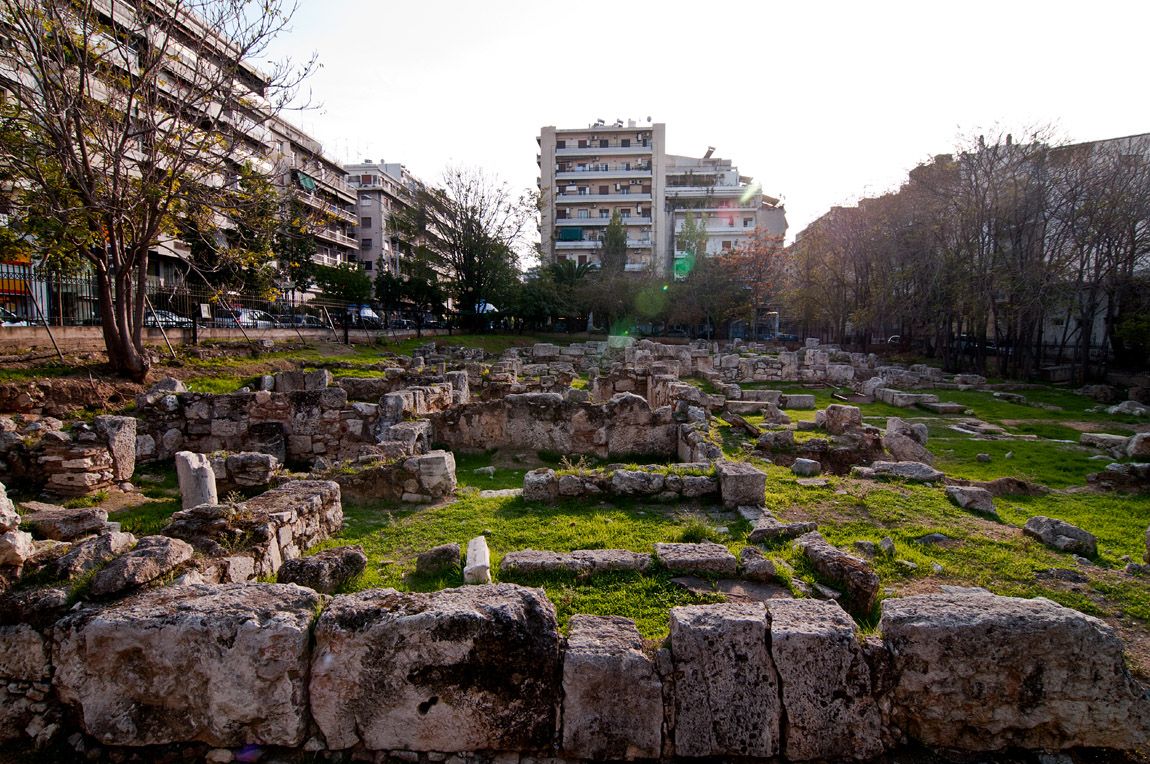Ancient Piraeus - Roman Residential Block Traditional Geocache
Ancient Piraeus - Roman Residential Block
-
Difficulty:
-

-
Terrain:
-

Size:  (micro)
(micro)
Please note Use of geocaching.com services is subject to the terms and conditions
in our disclaimer.

ENGLISH
At the given coordinates you will see a residential block of the roman period.
The interesting findings of the excavations in Piraeus are exhibited in the Archaeological Museum of Piraeus
The Cache
The cache is a small "custom made" magnetic canister (4cm long)
Containing logbook for name and date only.
Do not forget to bring a pen with you!
Please be very careful when searching for the cache because the area is full of muggles
Reinsert the cache carefully, at the exact point you found it and don't publish any "spoiler photo"
CAUTION: The "big box" is plastic. The only point that the small magnetic cache can be mounted , is right on the plastic washer with magnet.
If it drops you down and you can not catch it with something metal or magnetic, please report it.
HISTORY
Despite the fact that Piraeus had been inhabited by the middle of the 3rd millennium, it remained for many centuries an insignificant small city without any particular interest for the Athenians until its exploitation (5th century BC).
The appointment of Piraeus that was declared a municipality in 517 BC based on the administrative reform of Klisthenis, the founder of Athenian democracy, coincides with the period of acne of this democracy. This is due to the interest and the creative realisations of two important political people of that time: Themistocles and Pericles.
Themistocles’ interest for Piraeus was primarily expressed after the battle of Marathona in 492/493 BC when he was elected as ‘eponymous leader’. The works for the fortification of the city began before the naval battle of Salamina (480 BC) but it was completed between 471 and 465 BC. Later on (461-465 BC) more works followed for the extension of the Long Walls so that the linking of Piraeus with Athens could be achieved. Finally, during the years 451-431 BC the building and the final configuration of the city was completed with a prototypical – for its time – urban plan constructed by the famous architect and city planner Ipodamos the Milisius.
The rest of this interesting article relating to the history of ancient Piraeus you can read it at
http://www.pireasnet.gr/Default.aspx?tabid=669&language=en-US
ΕΛΛΗΝΙΚΑ
Στις δοθείσες συντεταγμένες μπορείτε να δείτε ένα "οικιστικό τετράγωνο του Ρωμαϊκού Πειραιά"
Τα ευρήματα των ανασκαφών της περιοχής του Πειραιά , εκτίθενται στο Αρχαιολογικό μουσείο του Πειραία.
Η Κρύπτη
Η κρύπτη είναι ένα μικρό μαγνητικό δοχείο "ιδιοκατασκευή" (4 εκατοστά μήκος)
Περιέχει log αρχείο για όνομα και ημερομηνία μόνο.
Μη ξεχάσετε να φέρετε τον στυλό σας.
Παρακαλώ να είστε προσεκτικοί κατά την αναζήτηση διότι το μέρος είναι πολυσύχναστο.
Επανατοποθετήστε την κρύπτη προσεχτικά, ΑΚΡΙΒΩΣ στο ίδιο σημείο που την βρήκατε και μη δημοσιεύσεται "Spoiler" φωτογραφία της κρύπτης.
ΠΡΟΣΟΧΗ το "μεγάλο κουτί" είναι πλαστικό. Το μόνο σημείο που μπορεί να τοποθετηθεί η μαγνητική κρύπτη, είναι ακριβώς πάνω στην πλαστική ροδέλα που είναι κολλημένη με τον μαγνήτη.
Εάν σας πέσει κάτω και δεν μπορείτε να την πιάσετε με κάτι μεταλλικό,παρακαλώ να το αναφέρετε.
ΙΣΤΟΡΙΑ
Παρά το γεγονός ότι είχε κατοικηθεί από τα μέσα της τρίτης χιλιετηρίδας, ο Πειραιάς, στους πρώτους ιστορικούς χρόνους και μέχρι την αξιοποίησή του (τον 5ο π.Χ. αιώνα), έμεινε για πολλούς αιώνες ασήμαντη πολίχνη, χωρίς ιδιαίτερο ενδιαφέρον για τους Αθηναίους. Η ανάδειξη του Πειραιά, που ας σημειωθεί, ανακηρύχθηκε Δήμος το 517 π.Χ.στη διοικητική μεταρρύθμιση του Κλεισθένη, του θεμελιωτή της Αθηναϊκής Δημοκρατίας, συμπίπτει χρονικά με την περίοδο της ακμής της Δημοκρατίας αυτής. Και οφείλεται στο ενδιαφέρον και τις δημιουργικές πραγματώσεις δύο μεγάλων πολιτικών μορφών της εποχής: του Θεμιστοκλή και του Περικλή.
Το ενδιαφέρον του Θεμιστοκλή προς τον Πειραιά άρχισε να εκδηλώνεται μετά τη μάχη του Μαραθώνα , το 492/493 π.Χ., όταν αναδείχθηκε "επώνυμος άρχων". Τα έργα για την τείχιση και γενικά για την οχύρωσή του άρχισαν οπωσδήποτε πριν από την ναυμαχία της Σαλαμίνας (480 π.Χ.), αλλά αποπερατώθηκαν ανάμεσα στο 471 και 465 π.Χ. Αργότερα (461-456 π.Χ.) ακολούθησαν άλλα έργα για την επέκταση των Μακρών Τειχών, ώστε να επιτευχθεί η σύνδεση του Πειραιά με την Αθήνα. Και τέλος, στην περίοδο 451-431 π.Χ. ολοκληρώθηκε η οικοδόμηση και η οριστική διαμόρφωση της πόλης, με ένα υποδειγματικό, για την εποχή, πολεοδομικό σχέδιο που είχε εκπονηθεί από τον διάσημο αρχιτέκτονα και πολεοδόμο Ιππόδαμο το Μιλήσιο.
Την συνέχεια του ενδιαφέροντος άρθρου σχετικά με τον αρχαίο Πειραιά μπορείτε να την διαβάσετε στο
http://www.pireasnet.gr/Default.aspx?tabid=669&language=el-GR
 !!! ΧΡΗΣΙΜΑ ΚΑΙ ΕΛΛΗΝΙΚΑ !!!
!!! ΧΡΗΣΙΜΑ ΚΑΙ ΕΛΛΗΝΙΚΑ !!!
Additional Hints
(Decrypt)
[ENG] Fcbgyvtug. Bar bs gur gjb.......vf snxr
[GR] Cebibyrnf. Ran ncb gn qlb .... rvanv cfrsgvxb